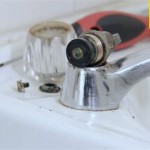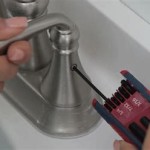How To Connect A Bathroom Sink Drain
Connecting a bathroom sink drain is a common plumbing task that can be accomplished by a homeowner with some basic tools and understanding of the components involved. A malfunctioning or improperly installed drain can lead to leaks, water damage, and unpleasant odors. This article provides a comprehensive guide to correctly connecting a bathroom sink drain, ensuring a watertight and functional plumbing system. Before beginning any plumbing project, it is imperative to prioritize safety. Water should be shut off at the main supply line or the individual shut-off valves located beneath the sink. This prevents accidental flooding during the drain connection process. Gather the necessary tools and materials, inspect the new drain assembly for any defects, and familiarize oneself with the steps before dismantling the old drain. ### Essential Tools and Materials:Successfully connecting a bathroom sink drain requires a specific set of tools and materials. Having these items readily available will streamline the process and minimize potential delays.
Tools:
- Basin Wrench: Also known as a sink wrench, this tool is designed to reach and loosen or tighten nuts in tight spaces, such as those found under a sink.
- Channel-Lock Pliers: These adjustable pliers provide a secure grip for loosening or tightening larger nuts and fittings.
- Adjustable Wrench: An adjustable wrench is useful for a variety of plumbing tasks, offering flexibility in grip size.
- Plumber's Putty: This pliable compound creates a watertight seal around the drain flange where it meets the sink basin.
- Teflon Tape (Plumber's Tape): Used to seal threaded connections, Teflon tape prevents leaks and ensures a tight fit.
- Screwdriver (Phillips and Flathead): Needed for removing and installing various screws that hold the drain assembly in place.
- Bucket: To catch any residual water in the drainpipes when disconnecting the old drain.
- Rags or Towels: To clean up spills and protect the work area.
- Gloves: To protect hands from dirt and potential contaminants.
Materials:
- New Drain Assembly: This typically includes the drain flange, rubber gasket, cardboard or friction washer, mounting nut, tailpiece, and P-trap.
- P-Trap: The curved pipe that traps water, preventing sewer gases from entering the bathroom.
- Tailpiece Extension (if needed): A section of pipe used to extend the tailpiece if the existing one is too short to reach the P-trap.
- Thread Sealant (optional): An alternative to Teflon tape that can be used on threaded connections.
The first step in connecting a new drain is to remove the old one. This requires careful disassembly to avoid damaging the sink or plumbing.
1. Shut Off the Water Supply: Locate the shut-off valves under the sink and turn them clockwise until they are completely closed. If there are no individual shut-off valves, turn off the main water supply to the house.
2. Disconnect the P-Trap: Place a bucket under the P-trap to catch any remaining water. Loosen the slip nuts that connect the P-trap to the tailpiece (the pipe extending from the sink drain) and the drainpipe in the wall. Use channel-lock pliers if the nuts are too tight to loosen by hand. Carefully remove the P-trap, emptying any remaining water into the bucket.
3. Loosen the Tailpiece Nut: The tailpiece is connected to the drain flange assembly with a large nut. Loosen this nut using a basin wrench or channel-lock pliers. This may require some effort depending on how tightly the nut is secured.
4. Remove the Drain Flange: With the tailpiece disconnected, the drain flange is the remaining part of the old drain assembly connected to the sink. Loosen the mounting nut that secures the flange to the sink from underneath. If the nut is corroded and difficult to remove, penetrating oil can be applied to help loosen it. Once the nut is removed, carefully push the drain flange up and out of the sink drain opening. A flathead screwdriver can be used to gently pry it loose if necessary.
5. Clean the Sink Drain Opening: Once the old drain is removed, thoroughly clean the sink drain opening. Remove any old plumber's putty or debris. A putty knife or scraper can be helpful for this task. Ensure the surface is clean and smooth to create a proper seal with the new drain.
### Installing the New Drain AssemblyWith the old drain removed and the sink drain opening cleaned, the new drain assembly can now be installed. This involves creating a watertight seal between the drain flange and the sink, and properly connecting the tailpiece and P-trap.
1. Apply Plumber's Putty: Roll a rope of plumber's putty between your hands to form a ring approximately ½ inch thick. Apply the putty evenly around the underside of the drain flange rim. Ensure there are no gaps or breaks in the putty. This putty will create a watertight seal between the flange and the sink.
2. Insert the Drain Flange: Carefully insert the drain flange into the sink drain opening. Press down firmly on the flange to ensure the putty creates a good seal against the sink surface. Remove any excess putty that squeezes out from under the flange with a putty knife or rag.
3. Assemble the Drain Components Under the Sink: From underneath the sink, slide the rubber gasket, followed by the cardboard or friction washer, and then the mounting nut onto the tailpiece. The order of these components is crucial for proper sealing and tightening. Tighten the mounting nut by hand until it is snug. Then, use a basin wrench or channel-lock pliers to further tighten the nut, ensuring the drain flange is securely held in place. Avoid over-tightening, as this could crack the sink.
4. Connect the Tailpiece: Attach the tailpiece to the drain flange assembly. Depending on the design of the drain assembly, this may involve screwing the tailpiece directly into the drain flange or using a slip nut and washer. Ensure the connection is tight and secure.
5. Install the P-Trap: Position the P-trap beneath the tailpiece. If the tailpiece is too short to reach the P-trap, a tailpiece extension can be used. Connect the P-trap to the tailpiece and the drainpipe in the wall using slip nuts and washers. Tighten the slip nuts by hand until they are snug, and then use channel-lock pliers to further tighten them. Ensure the P-trap is properly aligned to prevent leaks.
6. Check for Leaks: After the drain assembly is fully installed, turn the water supply back on slowly. Carefully inspect all connections for leaks. If any leaks are observed, tighten the corresponding nuts or fittings. If the leak persists, disassemble the connection and reapply plumber's putty or Teflon tape as needed. It is better to address leaks immediately than to allow them to cause water damage over time.
Install A Drain Stopper So The Is Removable
How To Install Bathroom Sink Drain Queen Bee Of Honey Dos

How To Connect A Bathroom Sink Drain
How To Install Bathroom Sink Drain Queen Bee Of Honey Dos

How To Install A Pipe From Sink Drain Wall Ehow

5 Natural Ways To Unclog A Bathroom Sink Hiller How

Bathroom Sink Plumbing Installation

Bathroom Sink Popup And Stopper Problems
How To Install Bathroom Sink Drain Queen Bee Of Honey Dos

Bathroom Sink Plumbing Diagram Diy Sinks Drain Kitchen Remodel
Related Posts







